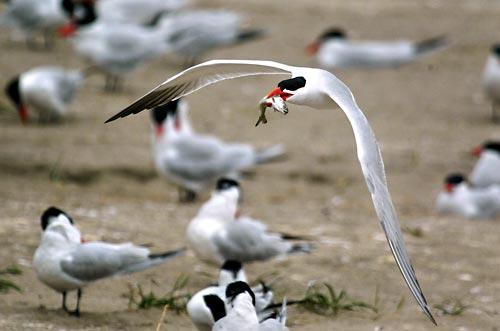forum
library
tutorial
contact

Study Relates More Fish
to Lower Survival Odds
by George Plaven
East Oregonian, April 10, 2015
|
the film forum library tutorial contact |

|
Study Relates More Fish
by George Plaven
|
A new study from the Independent Scientific Advisory Board looks at how tightly dense populations
of fish in the Columbia River might mean less benefit for future generations of the animals.

More fish in the Columbia River Basin doesn't necessarily bode well for survival of future generations.
That's according to a recent study by scientists examining the limitations of habitat and resources for endangered salmon and steelhead.
The report, released Feb. 25, draws a correlation between booming fish returns up the Columbia and a decline in smolts after spawning. Simply put, there is not enough food and shelter to support such heavy populations over the long run.
This concept is known as density dependence, and it's nothing new to fisheries managers. Researchers are surprised, however, to see signs of density dependence along the Columbia Basin, where fish runs -- though record-breaking in modern years -- are far below historical totals.
Evidence now shows the ecosystem is straining to keep up with the recovery of native fish returns. The data is laid out in a 246-page study by the Independent Scientific Advisory Board, serving NOAA Fisheries, Columbia tribes and the Northwest Power and Conservation Council.
Eleven scientists contributed to the research, including Greg Ruggerone, who works with the Seattle-based Natural Resources Consultants. Their findings could guide and influence everything from habitat restoration to releases from local hatcheries.
"Density is a factor that influences a lot in salmon, such as growth and survival," Ruggerone said. "The issue needs to be considered more directly in different areas of the basin."
By modern trends, salmon and steelhead returns were impressive in 2014. Approximately 2.5 million of the fish made it past Bonneville Dam for the year, including a single-day record of 67,521 fall chinook on Sept. 8. More than 14,500 coho made it all the way past Three Mile Falls Dam on the Umatilla River near Hermiston, compared to just 2,691 the previous year.
To put things in perspective, an analysis of historical data shows anywhere from 5-9 million adult fish returned to the Columbia River prior to the development of hydroelectric dams. For years, scientists thought the abundance of salmon in the basin was too low to bump up against the limits for food and habitat, Ruggerone said.
The advisory board's report now suggests otherwise. Ruggerone points to a number of factors, including dams and barriers that have effectively blocked off nearly one-third of spawning and rearing habitat for fish. Other habitat that is reachable has been damaged over the decades by building and development, he said.
The result is more fish competing for fewer resources. Ruggerone uses the analogy of an overcrowded dinner party: if there's only enough food for 20 people, but 50 people show up, there won't be enough for everyone. Some people will be leaving hungry.
Without enough food and shelter, juvenile fish will either grow more slowly or starve, and leave themselves open themselves to predators. So while salmon runs seem healthy now, they might not be in the years to come.
Ruggerone said their findings point to the need for habitat restoration that focuses on reducing those barriers to survival.
"We need to understand why density dependence occurs in different areas, and at what life stage," he said. "(Agencies) can use density dependence to guide their restoration activities, and evaluate the effectiveness of their activities."
Densities can also inform hatcheries where to release their juveniles, Ruggerone said, to avoid overwhelming the natural wild runs.
Henry Lorenzen, Oregon's representative on the Northwest Power and Conservation Council, said the report highlights the possibility they could be closer than thought to exceeding the basin's ability to support at-risk populations of salmon and steelhead.
"It means that, going forward, our recovery efforts will have to reflect this new information, and we may need to readjust our fish number goals," Lorenzen said.
More information about the study can be found online at www.nwcouncil.org.
Related Pages
The Density Dilemma: Limitations on Juvenile Production in Threatened Salmon Populations by Walters, Copeland, Venditti, Ecology of Freshwater Fish, 2/25/13
Independent Science Board: 'Density Dependence,' Diminished Habitat Constraining Salmon Recovery by Staff, Columbia Basin Bulletin, 2/27/15
learn more on topics covered in the film
see the video
read the script
learn the songs
discussion forum
